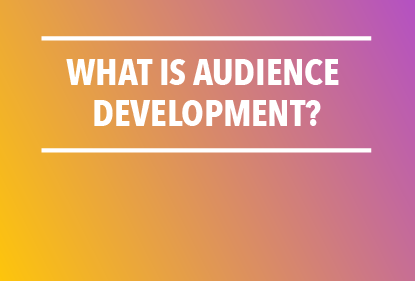Every brand’s audience has some characteristics in common — after all, each person chose that brand for a reason, right? Finding what brought an audience to a company can help the business market more effectively, hopefully bringing in more audience members with the insights gained. This process is part of the concept called audience development.
An Audience development strategy is a necessity for all businesses, and you may have already performed some parts of it without knowing. It is similar to many components of marketing, but with some subtle differences. So let’s go over audience development, its relationship to marketing, key elements and goals.
Audience Development, Defined
Audience development encompasses a broad umbrella of tasks that help you grow and nurture your audience. It involves several steps.
- Building relationships: Both existing and potential audiences can improve with the help of quality interactions. In building relationships, you create a direct connection to the customer, endearing them and improving their perception of your business.
- Gaining more customers: Of course, audience building is a necessary component of any company’s marketing efforts. Customer acquisition occurs through several methods, including referrals, value adds and targeted advertising.
- Increasing customer loyalty: When it comes to existing customers, you need to keep them coming back. Finding ways to make them repeat customers and improve brand loyalty can be extremely valuable to retaining and growing your audience base. You can even use these organic fans to help promote your product to others.
The majority of consumers — 63% — expect personalization to be a standard of service, and 53% feel a brand recognizes them individually when they get exclusive offers. Audience development strategies, especially if they use data, can help you get this personal edge and reach your customers on a personal level.
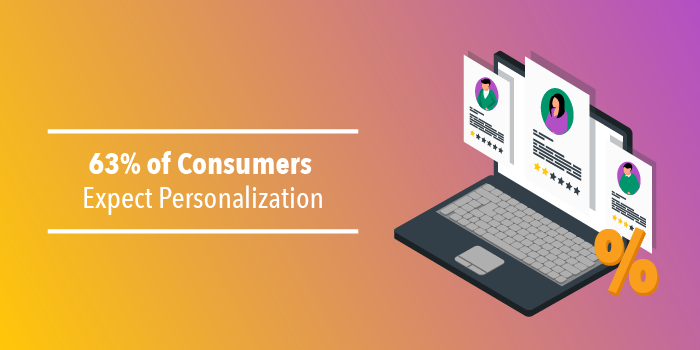
Audience development asks you to examine all facets of your target audience and use that information to reach them effectively and pull in new customers. Creating and promoting valuable content is a necessary step in growing an audience and building your brand, but if no one is around to engage with it, it can fall flat. A significant piece of audience development content strategy is about getting that content seen by the right people. Carefully reviewing your audience and learning about them allows you to send content where your target will receive it positively. It can help you turn anonymous users into loyal subscribers, repeat purchasers, etc.
Audience Development vs. Marketing — What’s the Difference?
Businesses in virtually every industry know audience engagement is essential to the growth of a company. It impacts customer acquisition rates, sales and more. While they may seem similar, marketing and audience development have a few subtle differences.
Marketing tends to focus on the product. That is, it is about showing your product to the customer in a way that shows them the benefits. Marketing materials can be highly targeted, reaching potential customers on a personalized basis and addressing individual needs. They can also be indiscriminate. Print advertisements, billboards, commercials, brand deals and more target anyone who sees them. Audience development focuses more on the human element of your audience — what they like about you, what they may want to see, how they use your products, etc.
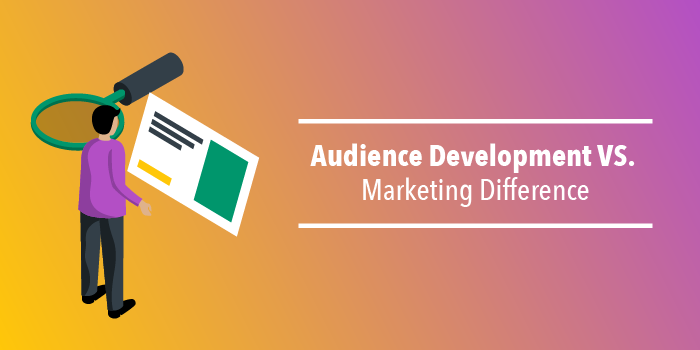
A significant difference between the two lies in pricing. Marketing relies on traditional advertising costs, including paying for space — think Facebook ads or Google, as well as print options — and the costs of creating the ad. These can add up quickly. Audience development, however, focuses on building relationships and leans into word of mouth and social media discussions. It can be much less expensive if not free to implement audience development campaigns.
All this is not to say that a business should choose audience development over marketing or vice versa, but that they are two complementary approaches that overlap frequently. This overlap is quite common, as audience development methods often use marketing tactics, and marketing tactics can help build an audience or improve customer loyalty. You can view marketing as a more direct, one-off approach, sharing the product with the right people, while audience development is more about getting people talking about your brand as a whole. A different way to look at it is as an approach to customer retention, another marketing concept that pulls customers in and converts them to loyal repeat buyers. However, these are typically positive side effects of the real goal — developing the audience. Some marketing tactics that overlap with audience development or may use the information gained from it include:
- Email campaigns
- Social media marketing
- Content marketing
- Soliciting user-generated content
- Targeted advertising
- Loyalty programs
- Referral programs
- Events
Audience development is much more dependent on the humans involved. It asks you to engage with your audience and get them talking. Encouraging referrals, shares, viral content and more can all provide successful audience development. Both approaches use extensive data, such as demographic information, preferences and more, to inform strategy and decisions.
The Key Aspects of Audience Development
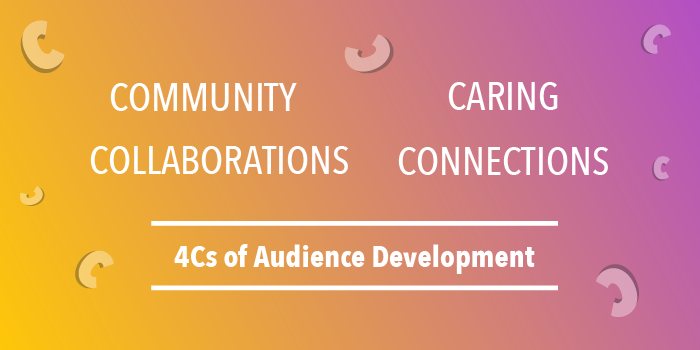
In any conversation about audience development, you’ll probably hear about the “4 Cs.” These are four concepts that identify the main principles of audience development.
1. Community
Audience development is about creating and being involved in a community, either by location or by your audience. By getting involved in your local community, you can increase brand awareness and give your audience a more positive view of your company. Contributing time and resources to a good cause is always an excellent way to build up your image.
On the other hand, building a community from scratch is powerful. Online forums, Facebook pages, LinkedIn groups, and Instagram communities are perfect examples of these. People flock to discuss the brands they love with other people online. Artists may share their creations and techniques, while health gurus show off their recipes. Many users are happy to tag a company whose product they like. Supporting this community and encouraging it can help your audience feel more in tune with your brand and other fans who share similar interests.
2. Connections
When you build relationships, you create connections. They are friends, family, members of your business network, even people you met on an online forum. Part of the benefit of building a community is that you create connections between people, meeting your audience on a more granular level.
3. Collaborations
We’ve learned from day one how essential collaboration is, and it applies to everything from departmental cooperation to audience interaction. Within your organization, you can encourage collaboration through the following methods.
- Marketing: Departments must work together to be as effective as possible. Sharing data, cross-promoting and other forms of cooperation can help you reach the right people.
- Corporate and social outreach partnerships: If you know your audience supports specific organizations, look into partnering with them. Social outreach is a great example. Working with organizations that resonate with your audience can increase their loyalty, and you may bring in customers from the other organization. Events and community outreach programs are great opportunities to reach the public — think libraries and schools.
- Featured content: Collaborate with your audience by having them submit real photos or reviews of them using your product. It’s free material, and many would love to have you feature them in front of your followers.
4. Caring
Finally, show your audience you care. Explain that you understand their desires and how you’re working hard to fulfill them. Thank them when they purchase from you and show your appreciation for their business. You’ll have to word these statements carefully, however, as authenticity is essential. Customers are becoming more and more skeptical of companies and advertisements. Case in point: 57% of consumers think that most brands create inauthentic content, but 86% find authenticity valuable when supporting a brand. Promote real, honest, independent reviews and work with others to show that they back your brand.
The Goal of Audience Development
Audience development can sometimes seem like a nebulous concept. There is no one measurement of how much your audience has developed, and it covers many different ideas. So what exactly are we trying to accomplish with audience development?
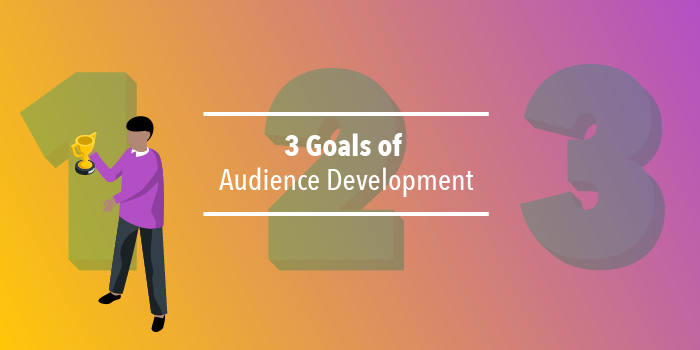
1. Develop a Greater Understanding of Your Audience
Audience development offers qualitative insight into the minds of your users. You can learn how they reach you, what they like and don’t like about your product or service and much more. When you know what makes your audience tick, you can use this to inform your product development and marketing efforts. You can appeal to your customers more successfully and add value they’ll truly appreciate.
For instance, if people begin to post about a new sweatshirt from a clothing company, that company can review comments and data from these posts to see what people liked about the shirt. Maybe they were raving about the addition of a secret pocket on the inside or something more abstract, like the company’s commitment to sustainable materials and work practices. The company could lean into the results, offering more information about their sustainability efforts or designing more products with hidden pockets.
Another piece of data a business can gather from these posts is targeting data. Say a company that makes golf clubs asks people to submit videos of their best swing with their new product. They may find the people most likely to submit a video were males in their 20s. In the future, when they want to promote user-generated content, they can target this audience segment more appropriately with the knowledge that they are likely to participate.
2. Increase Engagement Levels
As you interact with your audience and encourage community building, you also increase their engagement levels. You may find more responsive users who comment and respond to your posts and those of others promoting your content. High community engagement shows they are interested in what you’re saying and have indicated an emotional reaction.
3. Activate and Optimize Omnichannel Audience Development Initiatives
Reaching your audience across channels becomes easier when you know them and their habits. Omnichannel marketing uses all your channels or means of communication as one unified experience for the customer. It should be seamless, and knowing how your audience communicates can help you develop an omnichannel marketing strategy that works for them. If you know your audience responds well to push notifications because they like the new information it brings them, you could try sending them at opportune times, such as when they enter a store. On the other hand, if they like getting reminders of things they forgot, it might be better to send these notifications after they’ve abandoned an item in their cart. These approaches address your customers where they are most likely to appreciate the message and respond the way you want them to.
Why Audience Development Matters for Every Business
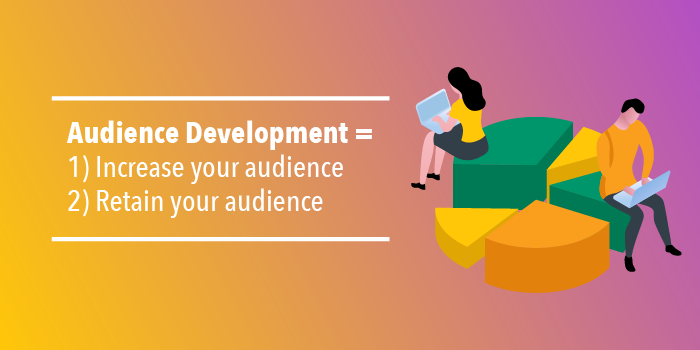
Today’s business world is more and more connected. Users can contact you and shop in a plethora of different ways. They can reach each other and strangers on social media to talk about your brand and product. Understanding as much as possible about your audience can help you with several goals, but here are two of the main features.
- Increase your audience: Plenty of media campaigns build off of the features that an audience already likes about a product. Getting more of these audience insights can make your understanding of the product more complete and accurate. You can also develop your new audience by leveraging an existing one
- Retain your audience: With an existing audience, you can build deeper relationships with them that may help keep them as your customer for much longer. Providing personalized experiences, showing your appreciation and continuing to offer the features they want can help build a loyal audience and keep them coming back to your brand over and over.
Whether you are a publisher, marketer or own a small mom-and-pop store, audience development strategies are vital to long-term success. Leaving the impressions your business makes up to chance can be messy at best, disastrous at worst. You want to be intentional with this aspect, so each experience your customers have is a positive one that keeps them coming back.
- If you understand your audience, you can market to them more appropriately, with a strong knowledge of their behaviors and characteristics. This awareness makes your marketing more efficient and can help you reach new customers.
- Growing an engaged audience, you can get people interacting with you and make them more involved with your brand. This interaction can improve customer loyalty and retention, making them more likely to remain customers and purchase your product.
- When you activate and optimize your omnichannel initiatives, you create a unified experience for the customer, linking different communication routes and streamlining the customer journey. Doing so can help you improve customer satisfaction and help you market to them more effectively.
However you want to use it, audience development is a vital component of every business.
Frequently Asked Questions
How do you use data to inform your audience development strategies?
How does audience development impact customer acquisition?
What are the best channels for audience development?
How Data and Lotame Can Help
Developing your audience is an excellent way to understand how they operate. You can learn why they behave the way they do and market more effectively. It also helps you grow your customer base, increasing business revenue.
Whatever method you choose for implementing audience development, Lotame tools can help you do it. From data collection on an individual level to providing access across devices, Lotame’s powerful suite of data technologies and tools, including second- and third-party data, can help you increase engagement across the board. Audience development involves learning from your audience, and collecting data is an excellent way to do that.
If you want to improve your audience development and increase engagement, contact us today to request a demo and see how Lotame can help you reach those business goals.

